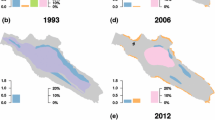Abstract
The submerged and emergent aquatic macrophyte vegetation of the eutrophic Lake Rerewhakaiitu was surveyed in February–March 1973, and is described qualitatively. At the time the lowered lake level had resulted in producing a sward of normally submerged aquatics as land forms. The principal dominant in the sward is Myriophyllum propinquum, the plants being greatly reduced in length to short stems with single entire leaves. At the uppermost levels Tillaea sinclairii is a significant component of the sward, and at lower levels Lilaeopsis lacustris behaves similarly. Below the uppermost submerged belt of macrophytes there is a characean meadow of Chara fibrosa and C. australis which in deeper waters gives way to Potamogeton ochreatus with either C. australis or Nitella hookeri. The high degree of eutrophication and consequent low light penetration has resulted in a vegetation limit at 4.5–5 m, which is lower than that found in other Rotorua lakes.
Similar content being viewed by others
Literature cited
Chapman, V. J., Brown, J. M. A. & Coffey, B. T. - 1972 - Submerged vegetation of the Rotorua and Waikato Lakes. 2 “Cyclic change” in Lake Rotoiti. N.Z. J. Mar. Freshw. Res., 5, (3/4), p. 461–482.
Author information
Authors and Affiliations
Rights and permissions
About this article
Cite this article
Chapman, V.J., Clayton, J. Submerged vegetation of the Rotorua and Waikato lakes 3. Lake Rerewhakaiitu. Hydrobiologia 47, 399–413 (1975). https://doi.org/10.1007/BF00039585
Received:
Published:
Issue Date:
DOI: https://doi.org/10.1007/BF00039585




